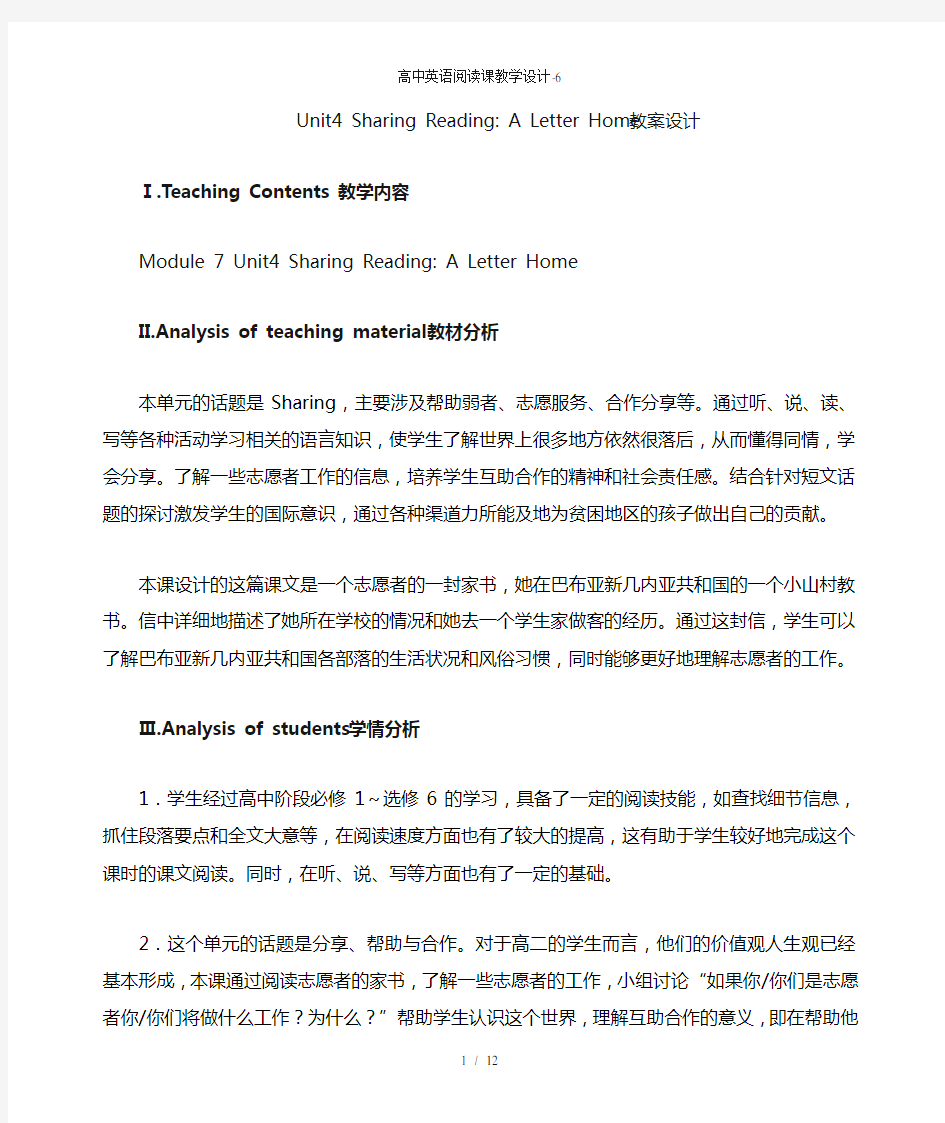
高中英语阅读课教学设计
- 格式:doc
- 大小:36.50 KB
- 文档页数:5


Unit4 Sharing Reading: A Letter Home教案设计
Ⅰ.Teaching Contents 教学内容
Module 7 Unit4 Sharing Reading: A Letter Home
II.Analysis of teaching material 教材分析
本单元的话题是Sharing,主要涉及帮助弱者、志愿服务、合作分享等。通过听、说、读、写等各种活动学习相关的语言知识,使学生了解世界上很多地方依然很落后,从而懂得同情,学会分享。了解一些志愿者工作的信息,培养学生互助合作的精神和社会责任感。结合针对短文话题的探讨激发学生的国际意识,通过各种渠道力所能及地为贫困地区的孩子做出自己的贡献。
本课设计的这篇课文是一个志愿者的一封家书,她在巴布亚新几内亚共和国的一个小山村教书。信中详细地描述了她所在学校的情况和她去一个学生家做客的经历。通过这封信,学生可以了解巴布亚新几内亚共和国各部落的生活状况和风俗习惯,同时能够更好地理解志愿者的工作。
Ⅲ.Analysis of students学情分析
1.学生经过高中阶段必修1~选修6的学习,具备了一定的阅读技能,如查找细节信息,抓住段落要点和全文大意等,在阅读速度方面也有了较大的提高,这有助于学生较好地完成这个课时的课文阅读。同时,在听、说、写等方面也有了一定的基础。
2.这个单元的话题是分享、帮助与合作。对于高二的学生而言,他们的价值观人生观已经基本形成,本课通过阅读志愿者的家书,了解一些志愿者的工作,小组讨论“如果你/你们是志愿者你/你们将做什么工作?为什么?”帮助学生认识这个世界,理解互助合作的意义,即在帮助他人的过程中实现自己的人生价值。
3.学生在这节课的学习过程中需要用到预习策略、搜集分析信息策略、归纳整理策略等。
Ⅳ.Design of Teaching Objectives 教学目标
1.Knowledge objectives 知识目标
(1)学生能够正确读写及运用本课出现的单词。
(2)学生掌握本课词组的意思并能在句子中熟练运用。
2.Ability objective能力目标
(1)强化略读、查读等阅读技能,训练通过寻找关键词、主题句等方式更快速并准确
地确定文章的段落大意,理清文章的总体框架与脉络的技能。
(2)增强阅读理解能力;发展借助图片、表格等非语言信息进行语言输出的能力。
3.Affective objectives 情感价值目标
(1)帮助学生理解志愿者工作的意义,培养学生在日常生活中帮助他人、扶贫救困的
爱心。
(2)在小组合作互动中,增强学生的团队合作精神与分享意识。
Ⅴ.Teaching Important Points(教学重点)
a.获取巴布亚新几内亚独立国各部落生活状况和风俗习惯的信息;
b.阅读能力的培养和阅读技巧的训练,如精读课文完成表格填空等。
Ⅵ. Teaching Difficult Points(教学难点)
a.理解作为志愿者工作的意义,从而树立正确的价值观;
b.训练用英语获取信息、处理信息、分析问题和解决问题的能力。
Ⅶ. Teaching Methods(教学方法)
1. Task-based method to make students interested in what they will learn.(任务型教学法)
2. Fast reading to get the general idea of the passage.(略读法)
3. Careful reading to get some detailed information.(细读法)
Ⅷ. Teaching Aids:(教学手段)
多媒体教学
Ⅸ. Teaching procedures (教学程序)
Step I Warming-up and lead in
1.幻灯片1
T: Class, firstly let’s enjoy a video and a song.
Ss: Enjoy the song and the video.
T: What can you see from the video?
Ss: I can see many students are planting trees/helping the disabled/cleaning the street…………
T: What can you learn from the video and the video?
Ss: We should devote our youthful power to the world.
2.幻灯片2
T: So we should learn to share.Ok,this is our today’s topic sharing. Our main task is reading.
2.幻灯片3
T: Now, class, just have a think, what do you mean by “sharing”? Let’s look at it.
Ss: Read the meanings together.
3.幻灯片4
T: The people who are helping others in the video are called volunteers. V olunteers are not paid which means they are not given money, not because they are not worthless but because they are priceless, but because they cannot be measured by money. Are you clear?
Ss: Yes.
T: Here is the sign of volunteer. Do you know what the sign stands for? A Hand?
Ss: Help.
T:A Heart? Ss: Love. T: A Dove? Ss: Peace. T: A Letter “Y”? Ss: Youth.
T: Do you want to be a volunteer?
Ss: Yes.
T: You are great. So you must know what a volunteer usually does.
4.幻灯片5-9
T: You can answer the question according to the pictures.
Ss: (give their answers)
T: (Sum up) Yes, there are different kinds of voluntary work volunteers can do.
[设计说明] 本环节主要是课文导入和热身环节,利用多媒体播放和本课主题相关的直观、生动的图片和音乐,创设轻松和谐的课堂气氛,激发学生兴趣,自然进入本课话题,教师联系生活实际展开教学。
Step II.Pre-reading
幻灯片10
T: Now, class look at the title and pictures try to guess “What’s the author’s work?”
Ss: She is a teacher..
T: Yes, she is also a volunteer, so she is great.
[设计说明] 通过看幻灯片呈现的题目和图片,让学生猜测本文作者的工作,激发